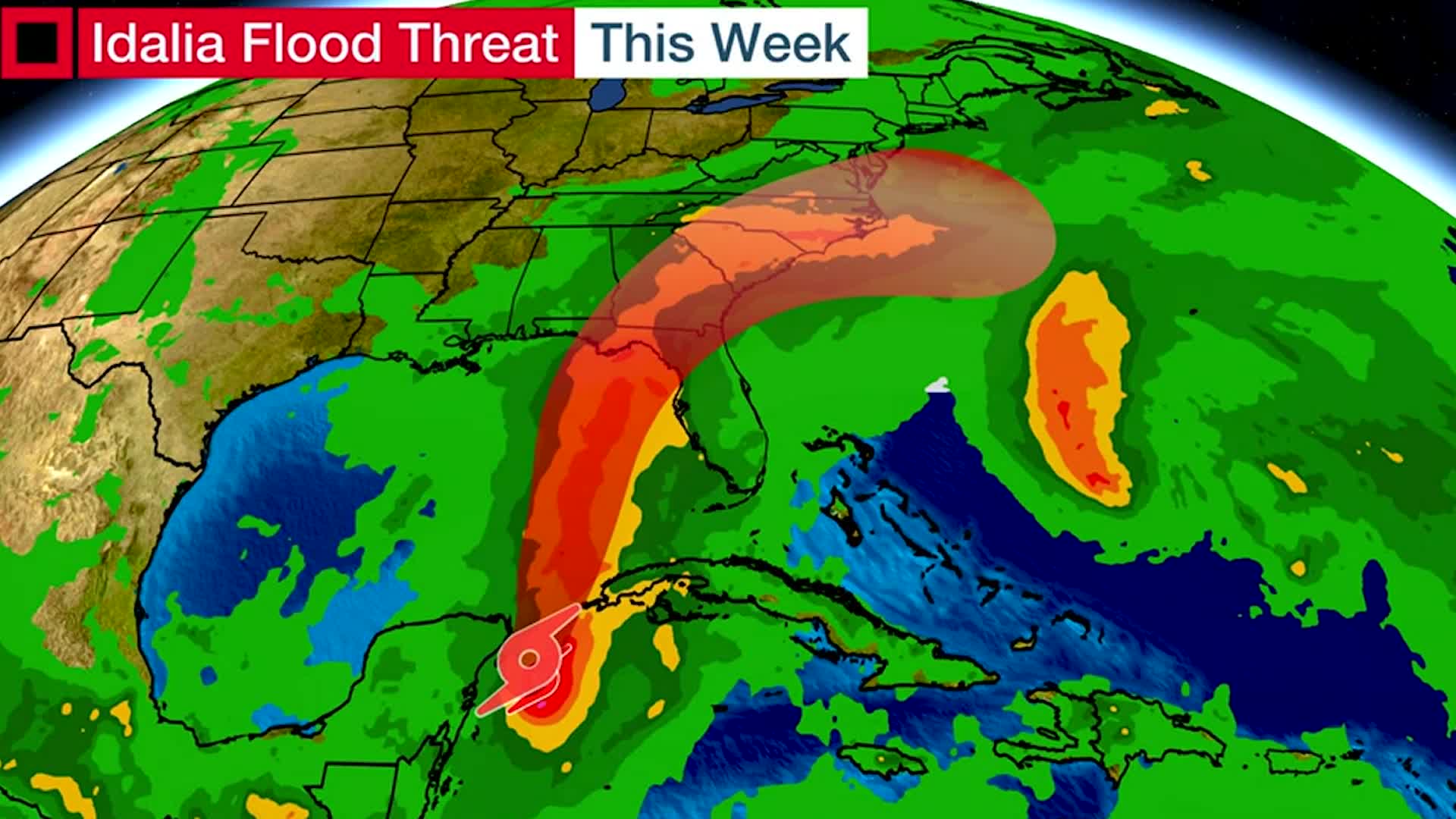MIAMI, Fla. – Tropical Storm Idalia formed Sunday off the coast of Mexico and is expected to land as a hurricane in the southern United States, according to the National Hurricane Centre.
Forecasters said the storm was about 95 miles (153 kilometers) east-southeast of Cozumel, Mexico, at 5 p.m. Sunday, moving northeast at 3 mph (4.8 kph) with maximum sustained winds of 40 mph (64 kph). Hurricanes have winds of 74 miles per hour (119 km per hour) or higher.
Forecasters predicted that Idalia will become a hurricane in the Gulf of Mexico on Tuesday and then turn northeast towards Florida’s west coast.
According to the latest Hurricane Centre estimates, Idalia could land in Florida on Wednesday with gusts of up to 100 mph (160 kph). That would classify it as a Category 2 hurricane.
Up to 11 feet (3.4 meters) of ocean water could rush on shore along a broad stretch of Florida’s west coast, sparking worries of severe floods.
At a press conference on Sunday afternoon, Florida Gov. Ron DeSantis stated that the forecast is still quite uncertain.
“This thing hasn’t even gotten to Cuba yet, and the water in the Gulf is very, very warm, so that will provide some fuel for this thing to pick up some more speed,” DeSantis explained.
When a tropical storm or hurricane approaches, large areas of Florida’s western coast are vulnerable to seawater spilling onto land and flooding settlements. According to Jamie Rhome, deputy director of the National Hurricane Centre, that area of Florida is extremely vulnerable to storm surges.
“So it will not take a strong system or a direct hit to produce significant storm surge,” he explained. “So if you’re anywhere along the Florida Peninsula, let’s say from Fort Myers northward to the Panhandle, you’ve got to be paying attention.”
Forecasters predicted that Idalia will become a hurricane in the Gulf of Mexico on Tuesday and then turn northeast towards Florida’s west coast.
Storm surge is one of the top concerns in Cedar Key, a fishing community that juts out into the Gulf of Mexico, according to Capt. A.J. Brown, owner of A.J. Brown Charters. The risk is that if the hurricane impacts Florida just to the north, Cedar Key will experience a tremendous surge from being on the storm’s southeastern flank.
Brown noted that there is concern in Cedar Key about a storm surge of two to five feet of ocean water and that if the storm surge hits five feet, “it would cover most everything downtown.”
The iconic Bridge Tender Inn in Bradenton Beach may have to remove a large tent covering the tiki bar area where musicians perform in preparation for Idalia, according to assistant manager Shannon Dunnan on Sunday.
“If we get a big storm, it’ll probably rip that tent in half,” she said.
However, Dunnan stated that the establishment will remain open for now.
The National Meteorological Service of Mexico warned on Sunday of heavy torrential rains and winds of up to 55 mph (89 kph) across the Yucatan Peninsula.
It warned that the storm could trigger everything from high waves to flooding in southern Mexico, primarily near coastal communities in Yucatán and Quintana Roo. It urged citizens to remain vigilant.
Forecasters predicted that tropical storm Idalia will become a hurricane in the Gulf of Mexico on Tuesday and then turn northeast towards Florida’s west coast.
On Sunday, Florida emergency officials encouraged homeowners to keep their petrol tanks at least half-full if they need to flee.
“This will ensure you can evacuate tens of miles inland to a safe location should the need arise,” said the Florida Division of Emergency Management on social media.
Florida has mobilized 1,100 National Guard personnel, and “they have at their disposal 2,400 high-water vehicles, as well as 12 aircraft that can be used for rescue and recovery efforts,” according to DeSantis, the Republican governor and presidential contender.
“If you are in the path of this storm, you should expect power outages,” he said. “So please prepare for that, especially if this storm ends up coming in the Tallahassee region, because there are going to be a lot of trees that will be knocked down, power lines that will be knocked down – that is just going to happen, so just be prepared for that and be able to do what you need to do.”
The state emergency management office has declared a state of emergency in thirty-three Florida counties.
So far this year, the East Coast of the United States has been spared by cyclones. Tropical Storm Hilary, on the other hand, produced widespread floods, mudslides, and road closures earlier this month in Mexico, California, Nevada, and points north.
The National Oceanic and Atmospheric Administration recently predicted that the 2023 hurricane season would be far busier than expected, partly due to abnormally warm ocean temperatures. The season lasts through November 30, with August and September being the busiest months.
SOURCE – (AP)






/cloudfront-us-east-1.images.arcpublishing.com/gray/HPBJE25TAFEHPA3TOSIEDQ75NE.png)



